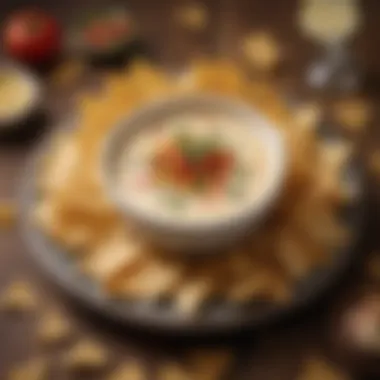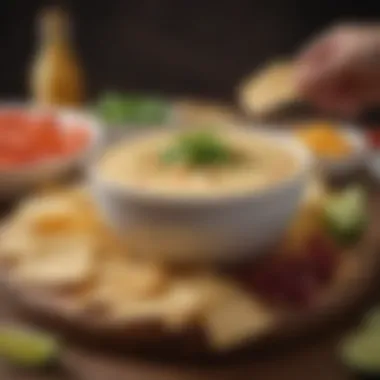Craft Authentic Mexican Queso at Home


Recipe Overview
Creating authentic Mexican queso at home is an approach to enjoying a dish that delights the palate. Known for its creamy texture and rich flavor, queso is more than just a dip; it is a culinary experience. This recipe is designed to yield approximately four servings, making it perfect for small gatherings or a hearty family meal. The total preparation and cooking time is about 30 minutes, making this recipe accessible for those with busy schedules. The difficulty level is rated as easy, making it suitable for both novice cooks and seasoned chefs alike.
Ingredients
Here is a quick list of the main ingredients you will need to make a classic Mexican queso:
- 2 cups of shredded Monterey Jack cheese
- 1 cup of heavy cream
- 1 cup of diced tomatoes with green chilies
- 1 tablespoon of taco seasoning
- Optional: fresh cilantro for garnish
Step-by-Step Instructions
1. Prep the Ingredients
Start by gathering all ingredients on your kitchen counter. Shred the Monterey Jack cheese if you haven’t purchased pre-shredded cheese. This will enhance melting and create a smoother texture. Prepare the diced tomatoes and ensure they are drained if they are canned. This prevents excess liquid from compromising the consistency of your queso.
2. Cooking Process
In a medium saucepan, add the heavy cream and heat over low to medium heat. It is important to stir frequently to prevent the cream from scorching on the bottom. Once the cream is warm, gradually add the shredded cheese while continuously stirring. This gradual incorporation helps achieve the desired creamy texture.
3. Add Flavor Elements
As soon as the cheese has melted, add in the diced tomatoes with green chilies and the taco seasoning. Continuously mix until all of the ingredients are well combined. Cook for an additional 2-3 minutes, allowing the flavors to meld together.
4. Time-Saving Strategies
If you are short on time, consider using a microwave-safe bowl to heat the cream and cheese in the microwave. Heat the cream first, then add cheese. Stir every 30 seconds until melted.
Nutritional Information
Each serving of this Mexican queso contains:
- Approximately 350 calories
- Proteins: 12 grams
- Fats: 30 grams
- Carbohydrates: 8 grams
This dish also offers beneficial nutrients such as calcium from the cheese and vitamin C from the tomatoes.
Quick Cooking Tips
- Using Kitchen Gadgets: A slow cooker can be utilized to make queso for larger gatherings. Just combine all the ingredients and let them cook on low for 2 hours.
- Multitasking: While waiting for the cheese to melt, you can prepare tortilla chips or other dippables.
- Healthier Alternatives: Consider using reduced-fat cheese and cream for a lighter option, or substitute sour cream for the heavy cream to alter the flavor profile.
Related Recipes & Variations
Explore other recipes that can complement your queso such as:
- Guacamole
- Spicy Pico de Gallo
You can also adapt this recipe based on dietary requirements, such as using vegan cheese for a dairy-free version.
Feel free to share your own innovative takes on this Mexican queso recipe; cooking is about creativity and personal touch.
Preface to Mexican Queso
Mexican queso represents more than just a dish; it is a culinary tradition that has deep roots in the rich tapestry of Mexican culture. Understanding the importance of queso is fundamental for anyone interested in creating this beloved dish. Queso's versatility allows it to complement various meals, from casual snacks to formal dinners, making it an essential element in Mexican cuisine. Moreover, learning to craft authentic queso empowers home cooks to replicate the true flavors of Mexico in their kitchens.
The process of making queso involves selecting the right ingredients and mastering specific techniques. This guide will explore the origins, cultural significance, and essential elements of this dish, providing a comprehensive overview that can enhance any culinary experience.
Origins of Queso
The historical roots of queso can be traced back to ancient Mesoamerican civilizations. The indigenous peoples of this region utilized available resources to create dairy-based dishes long before the arrival of European influences. Queso, specifically, draws its name from the Spanish word for cheese. As cheese-making techniques spread throughout Mexico, various regions adapted local flavors and ingredients, leading to the creation of different queso varieties. Traditional recipes often featured a blend of various cheeses and spices, each reflecting the local culture and agricultural practices.
These origins are still evident today, as many Mexican families maintain their ancestral recipes for queso. The craft of making queso not only connects to cultural heritage but also highlights the skills and techniques passed down through generations.
Cultural Significance


Queso holds a special place in Mexican cuisine, symbolizing community and togetherness. It is commonly served at gatherings, festive celebrations, and family dinners, serving as a dish that unites people. In many households, enjoying queso is a social experience, often accompanied by a variety of dippers, chips, and other sides, making it an interactive meal.
In addition to its role in gatherings, queso has become a symbol of Mexican identity. It showcases the country's rich agricultural diversity and culinary creativity. The popularity of queso extends beyond borders, with many people enjoying it in various contexts, further affirming its significance in food culture.
As both a basic household recipe and an intricate gourmet offering, queso adapts to personal tastes while honoring tradition. This duality is partly why queso resonates across generations, making it a cherished dish in both Mexico and beyond.
Essential Ingredients
The success of crafting authentic Mexican queso largely hinges on selecting the right ingredients. Each component contributes to the overall flavor and texture of the dish, providing depth and richness. Understanding these essential ingredients enhances your ability to create a memorable queso that suits various palates.
Cheeses Suitable for Queso
Choosing the right cheese is critical when making queso. The standard choices often include Monterey Jack, cheddar, and Oaxaca cheese. These cheeses melt well and provide the creamy consistency that characterizes good queso.
Monterey Jack is mild and buttery with a slight sweetness, making it a versatile choice. Aged cheddar, on the other hand, adds a sharp tanginess, deepening the flavor profile. Oaxaca cheese is stringy and similar to mozzarella, facilitating a unique melting quality.
Other cheeses such as Chihuahua cheese and cream cheese can also be excellent options to consider. Chihuahua cheese brings a creamy texture and slight nuttiness to the mix, enhancing the overall mouthfeel. Cream cheese can be used sparingly to achieve an even smoother queso. When selecting cheese, opt for quality over quantity, as the cheese serves as the primary foundation of your dish.
Spices and Seasonings
Spices and seasonings elevate the flavor of queso by providing contrast and complexity. Commonly used ingredients include cumin, garlic powder, and onion powder. Cumin infuses an earthy aroma, while garlic and onion powder contribute a savory depth.
Experimenting with chili powder or smoked paprika can introduce smoky notes to the dish, complementing the richness of the cheese. Fresh herbs such as cilantro can also add a burst of freshness.
Ensure that you select seasonings that resonate with your palate. Using quality spices, preferable fresh rather than powdered versions when possible, can make a notable difference in taste.
Additional Flavor Components
Beyond cheese and spices, additional elements can enhance your queso. Diced tomatoes and green chiles are widely used to introduce acidity and warmth. These add a textural contrast that tends to engage the palate more effectively.
If you want to create a spicier version, consider adding jalapeños or serrano peppers, ensuring to remove seeds if you prefer less heat. Other components such as cooked ground beef or chorizo can provide extra richness and protein, transforming queso into a heartier dish.
Considerations for using fresh versus canned ingredients can also influence the outcome. Fresh produce typically offers a more vibrant flavor, while canned options can provide convenience and stability in taste.
Selecting the right ingredients is essential for crafting an authentic Mexican queso that delivers on flavor and texture.
Preparation Techniques
Preparation techniques play a vital role in crafting an authentic Mexican queso. They determine not only the flavor profile but also the texture, creaminess, and overall experience of the dish. Using the right methods can elevate the simplest ingredients into a delectable delight. Understanding these techniques allows cooks to experiment confidently, making adjustments to achieve their desired results.
A good queso relies heavily on how cheese is melted and combined with other ingredients. Proper techniques ensure that the cheese does not clump up or turn grainy. Furthermore, paying attention to the order in which ingredients are incorporated can significantly affect the flavor. \n
Melting Cheese: Key Methods
There are several methods to effectively melt cheese for queso, each with its pros and cons. Here are a few key methods to consider:
- Stovetop Method: This is the most common method. It involves heating cheese slowly in a saucepan over low to medium heat, stirring consistently to promote even melting. This method avoids sudden temperature changes that can cause cheese to seize.
- Microwave Method: Quick and convenient, melting cheese in the microwave can save time. However, it requires careful monitoring. Cheese can easily become overheated, resulting in uneven melting. Melting in short intervals and stirring in between can help achieve optimal results.
- Double Boiler Method: This method involves placing a heatproof bowl on top of a pot of simmering water. It provides gentle, indirect heat that can result in a smoother melt. This is ideal for achieving a creamy texture without the risk of burning.
Ultimately, the choice of melting method may depend on personal preference and available time. Experiment with these methods to discover which one yields the best results for your queso.
Incorporating Ingredients
Incorporating other ingredients into melted cheese is crucial for crafting a flavorful queso. Timing and technique are important here, as they can enhance the taste and texture of the finished product.
- Gradual Addition: Start by adding ingredients like diced tomatoes, jalapeños, or spices gradually. Adding them too quickly can disrupt the melting process. Gradual incorporation allows for better blend and flavor integration.
- Layering Flavors: Consider the sequence in which you add your ingredients. Begin with sautéing onions or garlic to build a rich base flavor before adding cheese. This enhances depth and complexity in the queso.
- Texture Considerations: Some ingredients, like beans or meat, can introduce a different texture to the queso. Be mindful of how these will interact with the cheese. Mixing them in thoroughly can lead to a balanced consistency that makes each bite enjoyable.
Following these techniques will not only improve your queso but will also enhance your overall cooking skills. Focus on the preparation methods to craft a restaurant-quality experience in your home.
Step-by-Step Recipe for Classic Queso
Creating the perfect Mexican queso is both an art and a science. This section provides precise and practical steps to make classic queso that captivates the taste buds. The process will not only enhance your culinary skills but also enrich your understanding of the elements that contribute to a perfectly melty and flavorful mixture. Everyone can enjoy this dish, whether for a casual get-together or a formal dinner party.
Gathering the Staples


Before beginning, it is essential to have all ingredients ready. This approach streamlines the cooking process and prevents frustration.
Here are the main ingredients that you need:
- Cheese: Velveeta cheese and Monterey Jack are popular choices. They melt smoothly and create a creamy texture.
- Cream: Heavy cream or sour cream adds richness.
- Salsa: Choose a fresh salsa or jarred option. Diced tomatoes can work if salsa is not available.
- Spices: Cumin and chili powder are key. They boost the queso flavor.
- Optional Add-ins: Consider adding cooked ground beef, jalapeños, or black beans for variety.
Being organized is key. Prepare and measure these ingredients ahead of time to make the cooking more efficient.
Cooking Method Overview
The cooking method is critical for achieving a smooth consistency. The following steps outline the method of preparation:
- Melt the Cheese: Cut the Velveeta cheese into cubes. In a medium saucepan, combine it with Monterey Jack and cream. Use low heat to avoid scorching the cheese. Stir continuously until the cheese melts completely.
- Add Salsa: Once the cheese has melted, pour in the salsa. Stir well to combine everything. Begin with half a cup and adjust according to your taste preference.
- Seasoning: Add cumin and chili powder. Continue stirring until all spices are well-integrated.
- Check the Consistency: If it is too thick, add a bit more cream or even milk to create your desired creaminess.
This method ensures the dish remains creamy and does not become grainy, a common pitfall when melting cheese.
Finishing Touches
Finishing touches are crucial to elevate the flavor. Here are some tips:
- Toppings: Just before serving, consider sprinkling chopped cilantro, diced green onions, or shredded cheese on top. This adds color and a fresh flavor.
- Serving Warm: Serve the queso immediately in a warm serving bowl. Pair it with tortilla chips or fresh vegetable sticks for dipping.
- Garnish: A small dash of hot sauce can enhance the heat level according to taste.
Remember, queso is best enjoyed fresh! Consider reheating gently if needed, but avoid high heat to prevent the cheese from becoming tough.
Following this recipe will ensure that your classic queso delights your guests. Whether you stick to the basic recipe or add your unique twist, this dish is likely to become a favorite in your culinary repertoire.
Variations of Queso
Exploring variations of queso enriches the experience of this culinary delight. Each variation offers unique flavor profiles, catering to different preferences and dietary needs. Understanding these alternatives can expand your culinary repertoire and make queso a versatile dish in your kitchen. Whether you desire something spicier or prefer a lighter option, these variations can help meet your cravings.
Spicy Queso Options
For those who enjoy a kick in their queso, spicy variations are essential. Adding heat can transform a mild cheese sauce into a robust and exciting dish. Various ingredients can achieve this level of spice:
- Jalapeños: Fresh or pickled can add significant heat.
- Chipotle peppers: These provide both spiciness and a smoky flavor, enriching the base.
- Hot sauce: Adding a few drops of your favorite hot sauce can easily increase the heat level.
Consider combining these options for a well-rounded flavor. For example, jalapeños can be sautéed before mixing with cheese for enhanced depth.
Vegetarian and Vegan Alternatives
With the rise in dietary preferences, vegetarian and vegan alternatives for queso are indispensable. There are many ways to create delicious queso without animal products. Key components to consider are:
- Cashews: Soaked and blended for a creamy texture.
- Nutritional yeast: Adds a cheesy flavor that works well in vegan sauces.
- Vegetable broth: This can replace milk for a lighter, non-dairy version.
Experimenting with spices like cumin or chili powder can elevate the taste. These alternatives can satisfy health-conscious friends without sacrificing flavor.
Queso Blanco
Queso Blanco is a unique variation that sets itself apart from the traditional queso. With its milder and creamier texture, it serves as an ideal base for various toppings and enhancements. The smoothness comes from the choice of cheese, often using white cheeses like:
- Queso Fresco: It crumbles beautifully and adds a fresh taste.
- Oaxaca cheese: This melts well and brings a delightful stringiness.
Queso Blanco is often paired with sautéed vegetables or infused with herbs to create a refreshing dip or topping for different dishes. Its versatility makes it a popular choice for those seeking something less heavy than traditional quesos.
Serving Suggestions
Serving suggestions play a vital role in the enjoyment of Mexican queso. While the creamy and rich consistency of queso captivates the taste buds on its own, the right accompaniments and meal pairings can elevate the overall dining experience. Good serving suggestions not only provide variety but also complement the flavors of the queso. This section explores ways to enhance the presentation and flavor profiles of this dish.
Accompaniments and Dippers
Accompaniments are essential when serving queso, as they bring together flavors and textures. The right dippers can enhance the queso's creaminess and allow for a variety of tasting experiences.


Popular choices include:
- Tortilla Chips: Crisp and salty, they provide a perfect contrast to the rich cheese. Their sturdy shape holds up well, making them ideal for scooping.
- Vegetable Sticks: Carrots, cucumbers, and bell peppers add a fresh and crunchy element. They also provide a healthier option for those looking to cut calories.
- Soft Pretzels: These create a unique flavor combination with cheese. The softness complements the queso's texture, making it enjoyable and satisfying.
- Bread: Slices of sourdough or baguette can be great for dipping. A bit of toasting can enhance the bread's flavor, adding depth to the experience.
The key is to choose dippers that can hold the queso well, ensuring a robust taste as you savor each bite. Offering a variety of options encourages guests to experiment.
Pairing with Meals
When considering meal pairings with queso, it's important to harmonize the flavors in a cohesive manner. Queso is versatile and can accompany several types of dishes.
Here are some ideas for meal pairings:
- Tacos: Whether it's beef, chicken, or vegetarian tacos, queso makes for an excellent topping. It adds creaminess and a burst of flavor.
- Nachos: A classic pairing, nachos with melted queso create a shared experience perfect for parties or gatherings. You can customize toppings for diverse preferences.
- Grilled Meats: Queso pairs well with grilled chicken or beef. A dollop on the side or drizzled on top enhances the overall meal with a creamy contrast.
- Salads: For a lighter option, a fresh salad can be served alongside queso. Adding queso as a dressing or garnish brightens the dish without overwhelming it.
Common Mistakes to Avoid
When creating Mexican queso, it is essential to understand common pitfalls that can compromise the quality of the dish. Avoiding these mistakes not only enhances the taste but also ensures a smoother and more enjoyable cooking experience. The key here is awareness and preparation. Understanding potential errors can save time and ingredients, leading to a successful queso outcome.
Inappropriate Cheese Choices
Selecting the right cheese is critical when making queso. Many home cooks gravitate toward pre-shredded cheeses, thinking they are convenient. However, these cheeses often contain anti-caking agents, which can lead to a grainy texture instead of the desired creamy consistency. The best cheeses for authentic queso include monterey jack, queso blanco, or asadero. Each of these cheeses has melting properties that create a rich, velvety sauce.
If possible, grate cheese fresh from the block. This simple step can elevate your queso by ensuring a smooth melt. Be mindful to always combine different types of cheeses to create a more complex flavor profile.
Overheating Ingredients
Overheating your ingredients is another common mistake that can ruin your queso. It is tempting to turn up the heat to speed up the cooking process, but this can lead to separation and curdling. Instead, opt for a gentle heat. Start by melting the cheese over low heat, stirring consistently to prevent sticking and burning.
Make sure to monitor the temperature closely. A double boiler can be useful for maintaining an even temperature, ensuring that the queso remains silky and well-combined.
To achieve the best results, always heat your queso slowly. This patience pays off in flavor and texture.
When you focus on the right cheese choices and control the heating process, you significantly enhance your chances of making a delightful queso.
Nutritional Considerations
Understanding the nutritional aspects of Mexican queso is essential for anyone looking to enjoy this dish while being mindful of their health. Queso is often high in calories and saturated fat, depending on the cheese used. Additionally, it can be rich in sodium, particularly when incorporating processed cheese products or certain seasonings. Individual dietary needs vary, and being aware of these nutritional facts can help home cooks make better choices when crafting their queso.
It is also important to note that there are ways to enjoy queso that can align with healthier eating habits. This can involve being selective with ingredient choices and portion sizes.
Caloric Content Overview
The caloric content of queso can vary significantly based on the ingredients used. Traditional recipes often call for cheeses like Monterey Jack, cheddar, or Chihuahua cheese, each contributing a significant number of calories.
- Monterey Jack: About 110 calories per ounce
- Cheddar: Roughly 113 calories per ounce
- Chihuahua Cheese: Approximately 110 calories per ounce
Considering common add-ins like cream, salsa, or sour cream further increases caloric content. For example, sour cream adds around 60 calories for two tablespoons. It is vital to keep these values in mind, especially if serving queso as part of a larger meal.
"Making informed choices about cheese and additional ingredients can help control overall caloric intake while still enjoying flavorful queso."
Healthier Ingredient Substitutions
Selecting healthier substitute ingredients can significantly reduce the caloric and fat content of queso without sacrificing taste. Some options include:
- Low-Fat Cheeses: Instead of regular cheese, using low-fat versions can cut calories and saturated fat. Look for options like part-skim mozzarella.
- Non-Dairy Alternatives: Plant-based cheeses made from nuts or soy can provide a dairy-free option. Look for brands that offer a good melting quality.
- Greek Yogurt: As a substitute for heavy cream or sour cream, Greek yogurt adds creaminess with fewer calories and higher protein.
- Fresh Vegetables: Incorporating ingredients like chopped tomatoes, onions, or peppers not only adds flavor but also increases nutritional value with vitamins and fiber.
Incorporating these healthier ingredients can allow the enjoyment of queso while adhering to a more balanced diet. This deliberation can be beneficial especially for culinary enthusiasts who love to experiment with flavors while being conscious of their health.
Ending
In the realm of culinary arts, crafting Mexican queso stands as a remarkable skill worth mastering. This article has traversed various essential elements vital for creating authentic and flavorful queso. From understanding its origins and cultural significance to exploring ingredients, preparation techniques, and nutritional considerations, each facet contributes to a holistic cooking experience.
Recap of Key Points
- Origins and Cultural Heritage: Understanding the roots of queso enhances appreciation for its intricate flavors.
- Ingredient Selection: Choosing the right cheeses and seasonings ensures a rich flavor profile.
- Preparation Methods: Mastering techniques for melting cheese and blending flavors is crucial.
- Variations: Exploring spicy and vegetarian options caters to diverse palates.
- Serving Suggestions: Knowing how to pair queso with dippers and meals elevates the dining experience.
- Nutritional Awareness: Being conscious of caloric content and healthier substitutions enables smarter cooking choices.
Encouragement for Experimentation
The world of Mexican queso is not rigid; it thrives on innovation and personal taste. Home cooks should feel inspired to experiment with different cheeses, spices, and additional ingredients. Small adjustments can dramatically influence flavor and texture.
By doing so, anyone can discover unique versions of queso that resonate with their personal preferences.
Such creativity not only enhances the dish but also transforms the cooking process into a delightful journey.
Engaging with queso in a playful manner honors its traditional roots while inviting new interpretations.
Ultimately, the art of crafting queso is as much about individual expression as it is about following recipes.
Embrace this culinary adventure.







